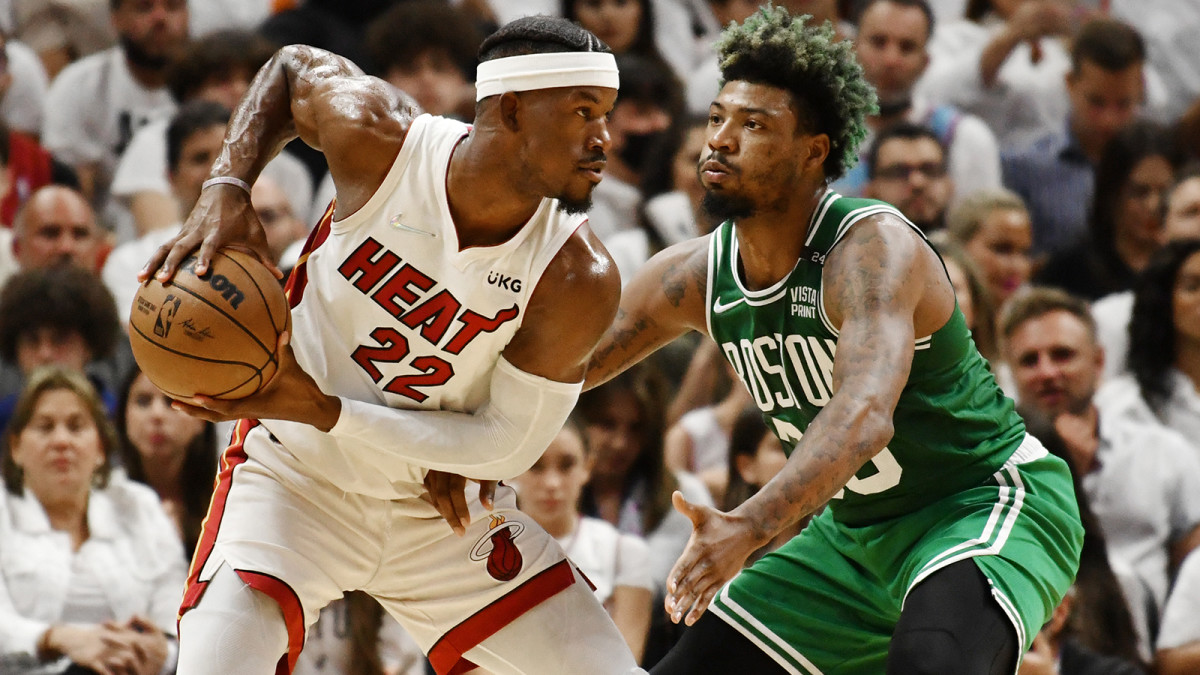Celtics Flex Their Defense vs. Heat in Game 2
The easiest way to explain Boston’s 127-102 win over Miami in Game 2 of the Eastern Conference finals is it was the exact opposite of why they lost Game 1. Without Marcus Smart and Al Horford in the series’ first game, Boston’s formidable defense looked helpless. In the rematch, with those two reliable veterans back in the starting lineup, pretty much every problem that presented itself on that side of the ball when they weren’t available no longer existed.
The Celtics shouldn’t have to remind anyone how dominant their defense—which has statistically been about as good during the playoffs as it was when it finished first in the regular season—truly is. In Game 2, with Smart and Horford back in the fold, those who forgot had a wonderful opportunity to refresh their memory. The Heat were strangled in the half-court, only mustering 86.5 points per 100 possessions against the league’s most complete, personal-space-invading, switch-heavy defense.

Boston forced and then contested long twos that were launched in desperation against a dwindling shot clock. They drove three-point shooters off the line and left non-threatening options wide open. They successfully mixed in the occasional blitz and flattened out an offense that got into the paint at will in Game 1. After that track meet, Boston kept Miami out of transition and only allowed eight fast-break points. It forced 14 turnovers and limited the Heat to a measly seven free-throw attempts in the first half, of which four did not go in. (Boston’s largest lead was 34 points so a few of these stats were compiled after the game was functionally decided.)
To get there, the Celtics made a few tactical adjustments that were mostly the byproduct of reinserting two of the league’s best defenders back into their starting lineup. The switching was amped up. But just as important, Boston’s defenders made plays in Game 2 that felt like a direct response to their hiccups in Game 1. At the heart of them was how they guarded Jimmy Butler, who played well but couldn’t replicate the out of body experience he had on Tuesday night.
Butler took 18 free throws in Game 1. On Thursday night he had eight. Watch Grant Williams’s arms after he recovers to slow down this drive by Butler, who rejects Bam Adebayo’s screen and seemingly has an open lane to the rim. Keep your hands high and visible and it’s a lot harder for the referee to spot any illegal contact.
From there, short of Boston allowing a slew of offensive rebounds to a group that could barely breathe if it wasn’t functioning within a second-chance opportunity, the Heat had no offensive answers. “We know what they are capable of defensively,” Erik Spoesltra said. “They have done this to some very good offenses. I'm sure they were not happy about us putting up 118 in Game 1. They came out and were very disruptive and got us out of our normal rhythm and flow, and then the shot making on the other end, you know, was very tough to overcome.”
To that point, this column could have also been about Boston’s effort behind the three-point line. They took 40 threes and made 20 of them. Jayson Tatum and Jaylen Brown’s independent shot creation in and outside the arc was nightmare fuel. They hit tough pull-ups, and sprayed the ball out to wide-open teammates. Smart finished with 12 assists and one turnover. Grant hit a few threes late in the first quarter that kept the floor spaced and established driving lanes for the ball-handlers. All those baskets early on allowed the Celtics to get set, find matchups and then keep everything in front of them with decisive switches. Horford was key here, be it against Butler, Gabe Vincent or Tyler Herro.
“I mean, Al is…what is he, 35, 36? And he's still moving like he's 22,” Smart said. “He's an athletic, long guy who can get out and switch on to those smaller, quicker guards, and it really keeps our defense compact. And it's not really a mismatch that teams can really try to go after.
Ime Udoka agreed: “We saw Herro get downhill a little bit too much, Butler as well last game and wanted to have bodies in front of bodies, and what we showed them at halftime was good physicality, good pickup points and good attention to detail on certain guys, aggressive reads, aggressive switches, and they pretty much saw a body every time they came off and didn't get a lot of clean shots, so we're happy with what we did tonight.”
Nothing about Boston’s performance in Game 2 was a revelation. Nights like it are inevitable when a defense that composed, complementary and locked in takes the floor with world-class scorers and shooters positioned to reap all the advantages subsequently provided on the other end.
It’s only one game in a series that can still bounce back and forth with slim margins, but this outcome wasn’t particularly surprising; when the most appropriate way to rationalize an overwhelming beatdown against the conference’s top seed—in their building, where they were previously undefeated in these playoffs—is with a shoulder shrug that suggests this is what’s supposed to happen when the Celtics have a healthy starting lineup, the opposition’s margin for error shrivels up.
All their switching led to quality shots. Defense fueled offense. All their quality shots led to more possessions where the Heat had to attack an impenetrable switch-happy scheme. Offense fueled defense. At this stage, the Celtics know what they are. They understand their strengths and flex them as often as they can. That’s a hard reality for Miami.
“It's muscle memory at this point,” Horford said when asked about Boston’s defensive identity. “We're getting out there, we're doing it, we're executing, and everybody is buying into it.”
More NBA Coverage:
